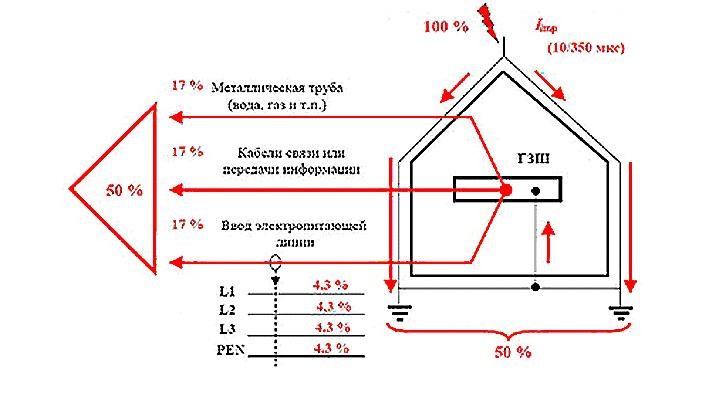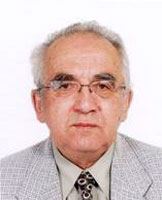The first part of the article "Methodics of calculation of SPD load currents"
Is there really such a need? There are enough reasons for doubts. Take a look at fig. 1. It was taken from the Internet. All the currents are strictly determined once and forever. Half of lightning current is taken by the building ground electrode system, which was hit by the lighting, and the rest of the current is equally shared between its metal utilities (power supply line, phone, water pipeline etc).

Fig. 1. Susbstitution scheme for the estimation of lightning current share in SPD protecting the electric network 380/220 V
Металлическая труба (вода, газ, итп) – metal pipe (water, gas, etc); ГЗШ – main grounding bus; Кабели связи или передачи информации – wires for connection or information transmission; Ввод электропитающей линии- input of power line
Similar schemes can be also found for other conditions. For example, in case of a direct lightning strike into the overhead power transmission line 380/220 V, it is offered to split the current equally: 50% to the right from the strike point, 50% to the left, and then in equal shares between the wires. And no calculations! In this recent situation, it is at least possible to understand the logics of the authors of this offer. They remembered, that the initial current distribution will be stated by the equal wave resistances of the line parts on a different side from the strike point. The lightning current will be really split equally, until the moment of its arrival to the place of waves' strike, reflected from the ends of the overhead power transmission lines. They move with the light speed, that is why the equation will last 1-2 ms. After that, everything will change, because the values of the reflected currents will depend on the loading on the ends of the overhead power transmission lines. In our case, it will be ground resistances, because low-voltage insulation of the line won't stand the overvoltage of a direct lightning strike and all its wires will be closed to the ground. It is quite real, that ground resistance on the side of the substation will be strongly different from the object ground resistance, which it is feeding. There won't be any currents equality.
But why the current in the ground electrode system on fig. 1 composes 50% fromthe lightning current. It is impossible to imagine. The most annoying thing, is that the method of current distribution in the system with the lengthy wires was developed in detail more than a century ago. Today, computer equipment takes away all the problems of solving wave equations in partial derivatives, by which the process is described. It is enough to know the capacitance value C and inductivity of the overhead line L, its longitudinal running resistance R and grounding resistance at the ends of Rоб, Rпс in order to find the current chare in ground resistance of the object and of the line itself.
Choosing the substitution scheme for your task, you need to remember that the calculation by the scheme with the concentrated parameters obliges you to track changes of currents and voltages only in time, whereas it is also necessary to control the dynamics of the process on the line length beside the time correlation in the scheme with the distributed parameters. It strongly increases the calculation volume in N times for a line split into N spacial cuts.
The desire of the engineer to avoid complex calculations at the design is quite reasonable. However the solution of equations for a long line is not an easy process, it is better to start with it, in order to have standard solutions with which it will be possible to compare what is given by the simplified calculation schemes. Only this way it is possible to sort the tasks, singling out those which are subject to easy estimations and concentrate on the more laborious ones, which require full substitution schemes with distributed parameters.
E. M. Bazelyan, DEA, professor
Energy Institute named after G.M. Krzyzanowski, Moscow
Read more "2. The use of substitution circuit with the distributed parameters at a direct strike into the object."
See also:
- How to choose lightning rods after all? (article by Professor E.M. Bazelyan)
- Lightning protection of high-rise buildings (article by Professor E.M. Bazelyan)
- Free webinars for designers of grounding and lightning protection
- Grounding and lightning protection projects in dwg, pdf formats
- Free consultations and assistance in calculation of grounding and lightning protection
Related Articles:
 Lightning protection of residential and public buildings - answers to frequently asked questions in the design
Lightning protection of residential and public buildings - answers to frequently asked questions in the design
 Lightning Protection of Large Territories: Parks, Grounds, Plant Territories. Page 1
Lightning Protection of Large Territories: Parks, Grounds, Plant Territories. Page 1
 Lightning Protection of Large Territories: Parks, Grounds, Plant Territories. Page 2
Lightning Protection of Large Territories: Parks, Grounds, Plant Territories. Page 2
 Lightning Protection of Large Territories: Parks, Grounds, Plant Territories. Page 3
Lightning Protection of Large Territories: Parks, Grounds, Plant Territories. Page 3

